 Holy Evening, Christmas Eve, Rich Evening, Rich Kutia - these are the names of a great Christian holiday held in the evening on Christmas Eve. Orthodox Christians celebrate it on January 6th.
Holy Evening, Christmas Eve, Rich Evening, Rich Kutia - these are the names of a great Christian holiday held in the evening on Christmas Eve. Orthodox Christians celebrate it on January 6th.
Christmas Eve marks the beginning of the winter holidays - Christmas, which last two weeks and end with the holiday of Epiphany, which is celebrated according to Orthodox tradition on January 19th.
All Christians begin preparing for the celebration of Christmas long before the holidays. Back in the fall, during the harvest, Ukrainians would make a Rai-Didukha for the upcoming holiday - a sheaf of oats, wheat, rye and other cereals tied with straw, and also prepare hay from fragrant herbs. By the holidays, all the main household work had to be completed: all the buildings in the yard were put in order and the yard itself was arranged, household tools were repaired and neatly laid out, the weaving of cloths was completed and the necessary renovations were sewn.
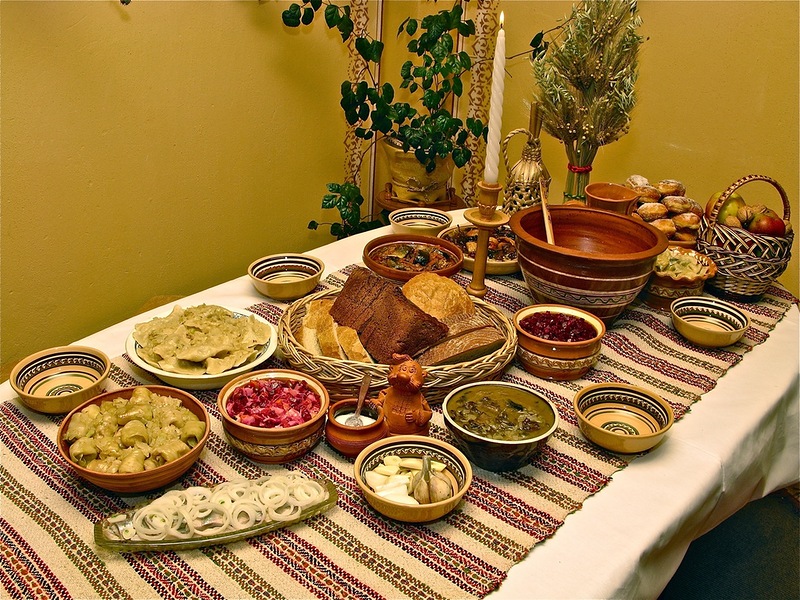 In Ukrainian families, women tried to bring cleanliness and order to the entire house before the winter holidays, whitewashed the walls and ceilings in the house, painted the stove and walls with drawings with folk motifs, decorated the home with festive embroidered towels, tablecloths, curtains. They sewed or bought new clothes for all the household members, and bought new beautiful dishes for the household - pots, makitras, makogons and other utensils. People made candles for the holidays themselves from wax collected in the warm season in the apiary.
In Ukrainian families, women tried to bring cleanliness and order to the entire house before the winter holidays, whitewashed the walls and ceilings in the house, painted the stove and walls with drawings with folk motifs, decorated the home with festive embroidered towels, tablecloths, curtains. They sewed or bought new clothes for all the household members, and bought new beautiful dishes for the household - pots, makitras, makogons and other utensils. People made candles for the holidays themselves from wax collected in the warm season in the apiary.
The entire Orthodox Ukrainian people, from toddlers to the elderly, were preparing for the winter holidays with joyful anticipation. The elders taught the children old Ukrainian carols and schedrivkas. The youth were actively preparing for the carols. Young men and women gathered in companies, invented and learned songs and jokes for the carols, made costumes and equipment. The roles of the traditional Ukrainian nativity scene and carol singers were distributed - the birch (otaman), the mikhonoshi, the treasurer and other characters.
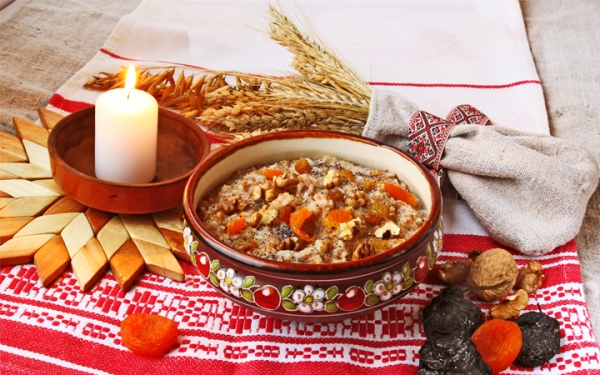 The day before Christmas, on January 6, according to the new style, the hosts began to prepare kutya and uzvar before dawn, which were considered God's food. The preparation of God's food was carried out in accordance with the ancient Ukrainian ritual. The firewood in the oven was laid out in a special way, and lit with a "live" fire - a spark from a flint or the friction of two pieces of wood, which were later replaced with matches. Water for cooking was used "unopened", that is, collected before dawn. Similarly, "before dawn" it was necessary to bake knish, which was kneaded like regular bread, but with a small loaf on top, which was called a soul. This loaf was intended for the souls of deceased relatives. After knish, lean pies were placed in the oven. Then other lean dishes were prepared on unopened water in new dishes. Twelve lean dishes were to be on the festive table on Christmas Eve.
The day before Christmas, on January 6, according to the new style, the hosts began to prepare kutya and uzvar before dawn, which were considered God's food. The preparation of God's food was carried out in accordance with the ancient Ukrainian ritual. The firewood in the oven was laid out in a special way, and lit with a "live" fire - a spark from a flint or the friction of two pieces of wood, which were later replaced with matches. Water for cooking was used "unopened", that is, collected before dawn. Similarly, "before dawn" it was necessary to bake knish, which was kneaded like regular bread, but with a small loaf on top, which was called a soul. This loaf was intended for the souls of deceased relatives. After knish, lean pies were placed in the oven. Then other lean dishes were prepared on unopened water in new dishes. Twelve lean dishes were to be on the festive table on Christmas Eve.
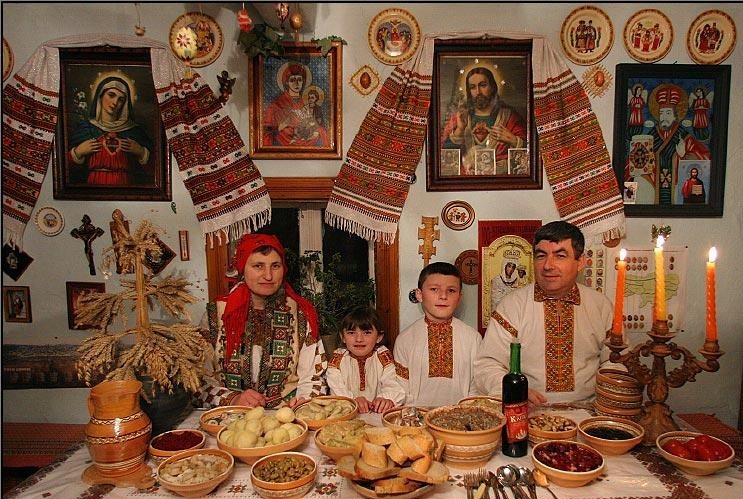 The finished wheat for kutia was taken out of the oven and nuts, raisins, poppy seeds and honey were added to it. Wheat symbolized eternal life, honey - the happiness of the Saints in Heaven. The stew was cooked on pre-dawn water from dried fruits - dried apples, plums, pears, cherries. All God's food must be ready before sunrise.
The finished wheat for kutia was taken out of the oven and nuts, raisins, poppy seeds and honey were added to it. Wheat symbolized eternal life, honey - the happiness of the Saints in Heaven. The stew was cooked on pre-dawn water from dried fruits - dried apples, plums, pears, cherries. All God's food must be ready before sunrise.
At dawn, with the first rays of the rising sun, the owners opened all the doors in the house, in the outbuildings, opened the gates to the yard to let abundance, wealth, and a good harvest into their household. They sprinkled the consecrated poppy on livestock and other animals, as well as barns and cellars, to protect the household from evil forces. When everything was ready for the holiday, "Svyatki" were brought into the house - ritual symbols of the upcoming holidays. The father and his eldest son followed them to the barn. The father carried "unopened" water, and his son held three ears of corn in his hand. In the barn, the owner sprinkled the bundles of hay and Rai-Didukh, prepared in the fall, with the water brought and read prayers, thanking God for the harvest given last year and asking for a good harvest, prosperity, and health in the coming year.
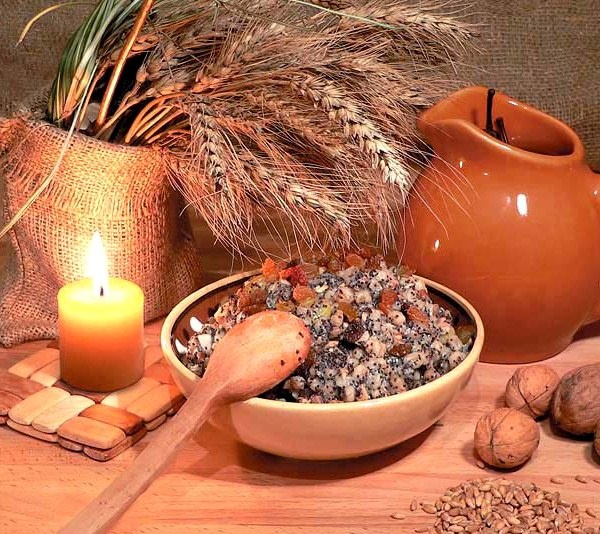 Taking Rai-Didukh and a large bundle of hay, the father and son carried them into the hut. The hostess met them on the threshold, holding a book and a lighted candle in her hands. Didukh was installed in the Holy Corner - the pen, and hay was spread on the table and floor in the hut. The children happily rolled around in the fragrant hay on the floor - this ritual contributed to the abundance of livestock in the yard.
Taking Rai-Didukh and a large bundle of hay, the father and son carried them into the hut. The hostess met them on the threshold, holding a book and a lighted candle in her hands. Didukh was installed in the Holy Corner - the pen, and hay was spread on the table and floor in the hut. The children happily rolled around in the fragrant hay on the floor - this ritual contributed to the abundance of livestock in the yard.
The ancient Ukrainians believed that the spirits of ancestors, the spirit of the home, and the Lada spirits who are kind to people reside in the Paradise-Grandfather during the harvest and appear with him in the barn and in people's houses, while the unkind spirits leave the fertile fields for distant forests and fields. On Christmas Eve, when people bring the Paradise-Grandfather into the house, the good spirits and the spirits of ancestors who are in paradise (hence the name Paradise) are present at the Holy Supper.
During the entire time that Rai-Didukh was in penance, the owners were not supposed to do any work. They even took the broom out of the house, because it was not allowed to clean the house. They could only look after the livestock. People celebrated and had fun all the days of the holiday. Every evening, starting from Christmas Eve and until the Generosity Evening, was considered Holy.
According to Ukrainian tradition, two tablecloths were spread on the table. The first one was used to cover the hay on the table. This tablecloth was intended for good spirits, garlic or magic potions were spread on it at the corners of the table. A second tablecloth was placed on top, on which, in the center of the table, the host placed a knish, and the hostess - a loaf with a candle.
 The top layer was collected from the kuti and given to the livestock. This ritual was accompanied by the buzzing and clucking of small children so that there would be many bees and chickens in the household. The bowl with the kuti and the uzvar were taken to the pokut, then the kuti was covered with a knish, and a loaf of bread was placed on the uzvar. At this, the daytime ritual actions ended, and the whole family waited for the evening.
The top layer was collected from the kuti and given to the livestock. This ritual was accompanied by the buzzing and clucking of small children so that there would be many bees and chickens in the household. The bowl with the kuti and the uzvar were taken to the pokut, then the kuti was covered with a knish, and a loaf of bread was placed on the uzvar. At this, the daytime ritual actions ended, and the whole family waited for the evening.
All this day, all the household members, except for the little ones, did not eat anything, because it was the last day of the Christmas fast. Everyone waited for the first star to appear in the night sky. For the festive dinner on Christmas Eve, people put on beautiful clothes specially prepared for this holiday.
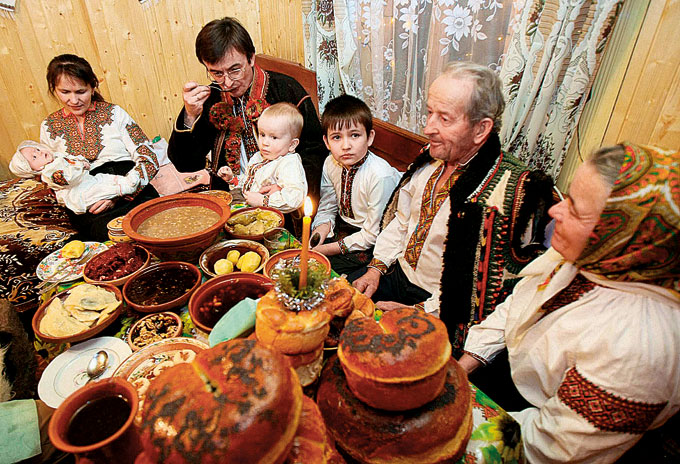 The children ran out into the yard, trying to be the first to notice the appearance of a star. When the star began to shine in the sky, the children joyfully informed their relatives about it. The feast of the Holy Evening began. The host solemnly sat down at the table, and behind him, in turn, the whole family sat down, from the eldest to the youngest. Before sitting down, everyone respectfully blew on the bench so as not to accidentally sit on one of the spirits of the ancestors, who, according to legend, were present in the house that evening. While the Holy Evening was going on, it was forbidden to get up or talk loudly. Only the hostess got up to serve food, and the host had a respectful conversation with the older members of the household.
The children ran out into the yard, trying to be the first to notice the appearance of a star. When the star began to shine in the sky, the children joyfully informed their relatives about it. The feast of the Holy Evening began. The host solemnly sat down at the table, and behind him, in turn, the whole family sat down, from the eldest to the youngest. Before sitting down, everyone respectfully blew on the bench so as not to accidentally sit on one of the spirits of the ancestors, who, according to legend, were present in the house that evening. While the Holy Evening was going on, it was forbidden to get up or talk loudly. Only the hostess got up to serve food, and the host had a respectful conversation with the older members of the household.
All day and evening of January 6, it was not customary to leave the house, go to visit, and nothing could be borrowed. The whole family had to be together, and if anyone had left the house before that, they tried to return before the holiday. Before the Holy Supper, the host would say a prayer, then put the kutya in a new makitra, add honey and grated poppy seeds to it, and put the makitra with the kutya on the table next to the Knysh and the loaf.
 The eldest member of the family, taking a spoonful of kutia, recited a prayer for the deceased parents and all the ancestors, as if inviting them to dinner. According to tradition, for them and for those who were currently absent from home, two glasses and two plates with kutia stood on the table, which no one touched. In some areas, a spoonful of kutia was ritually thrown up, almost to the ceiling, asking God for a good crop of cattle and other living creatures. After that, the head of the family filled the glass and recited a prayer by which the members of his family live. Then the glass was passed to the next adult relative. All dishes were eaten with spoons from large common bowls.
The eldest member of the family, taking a spoonful of kutia, recited a prayer for the deceased parents and all the ancestors, as if inviting them to dinner. According to tradition, for them and for those who were currently absent from home, two glasses and two plates with kutia stood on the table, which no one touched. In some areas, a spoonful of kutia was ritually thrown up, almost to the ceiling, asking God for a good crop of cattle and other living creatures. After that, the head of the family filled the glass and recited a prayer by which the members of his family live. Then the glass was passed to the next adult relative. All dishes were eaten with spoons from large common bowls.
Of course, there were also special signs associated with the Holy Supper. If a young man suddenly sneezed during dinner, he would be a good Cossack, and if a girl sneezed, she would get married this year. In a wealthy family, the father would give a foal to the son, and a calf to the daughter as a dowry. It was a good sign if a lonely, poor person or traveler came to the Holy Supper. He was welcomed and generously treated.
On the table on Christmas Eve there were always twelve different Lenten dishes. Usually, in addition to kutya and uzvar, there were dumplings, pancakes, porridge, borscht, fish and mushroom dishes, cabbage rolls and pies. The dinner lasted for several hours. Then the hostess cleared the dishes from the table, but kutya, uzvar and some other dishes remained on the table to treat the spirits. Additionally, a glass of clean water was placed, and a towel was left.
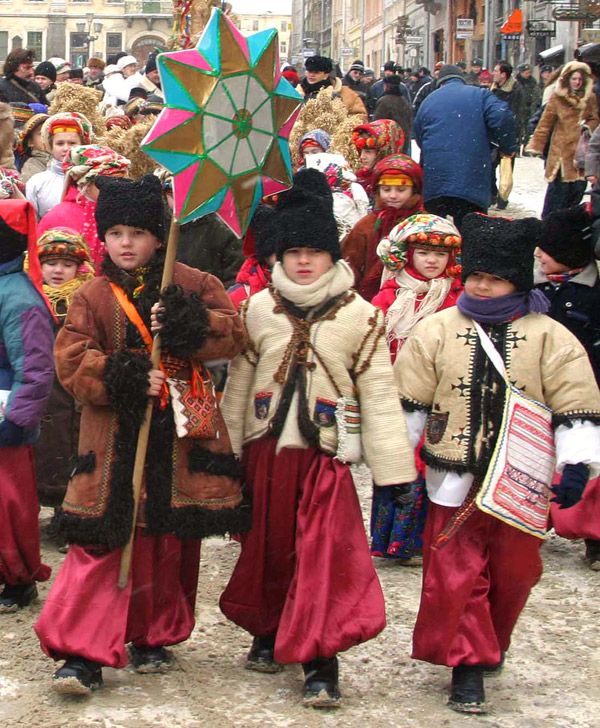 The dinner was over, but the holiday continued. The whole family sang carols, calling for a good harvest, a rich offspring of livestock and poultry, pleasant, joyful events to their home. Interesting fortune-telling was arranged, for example, on the stalks of hay that were under the tablecloth. The hosts gave out gifts, first of all to the children, and then to all family members, and they also gave the hosts gifts prepared in advance. The rite of giving gifts symbolized the wish for wealth and prosperity, and also demonstrated the love of family members for each other.
The dinner was over, but the holiday continued. The whole family sang carols, calling for a good harvest, a rich offspring of livestock and poultry, pleasant, joyful events to their home. Interesting fortune-telling was arranged, for example, on the stalks of hay that were under the tablecloth. The hosts gave out gifts, first of all to the children, and then to all family members, and they also gave the hosts gifts prepared in advance. The rite of giving gifts symbolized the wish for wealth and prosperity, and also demonstrated the love of family members for each other.
On Holy Evening, people did not sleep, celebrating until the very morning. If they wanted to rest, they lay down right in their clothes, trying not to fall asleep. The candles were not extinguished, they shone for a long time until they burned out completely, so the windows of the houses were lit all night, creating a festive look in the village. Family members did not borrow anything from relatives, especially from guests, and tried not to leave the yard. This was a bad omen. Only children could leave the house to take the ritual dinner to their godchildren, if they lived nearby. On Holy Evening, it was not customary to have unbridled fun. People talked calmly about household topics, remembered their ancestors. On this evening and night, quarrels, evil words, bad wishes were not allowed, since evil spirits and witches were listening under the windows, they could fulfill everything bad that was accidentally said.
 Early in the morning, before dawn, boys-congratulators went from yard to yard. They greeted the owners with greetings and congratulations. There was a sign that this morning the first to enter the house should be a man or a boy, this promised good luck for the whole year. Therefore, everyone waited for the boys and treated the congratulators with sweets, nuts, fruits and gave them money.
Early in the morning, before dawn, boys-congratulators went from yard to yard. They greeted the owners with greetings and congratulations. There was a sign that this morning the first to enter the house should be a man or a boy, this promised good luck for the whole year. Therefore, everyone waited for the boys and treated the congratulators with sweets, nuts, fruits and gave them money.
Nowadays, the traditions of Holy Week are observed by most people in both villages and cities. Not all rituals are remembered, but the main customs - to celebrate the holiday with the whole family, with good thoughts and wishes, with gifts and treats - still live and are revered by the Ukrainian people.

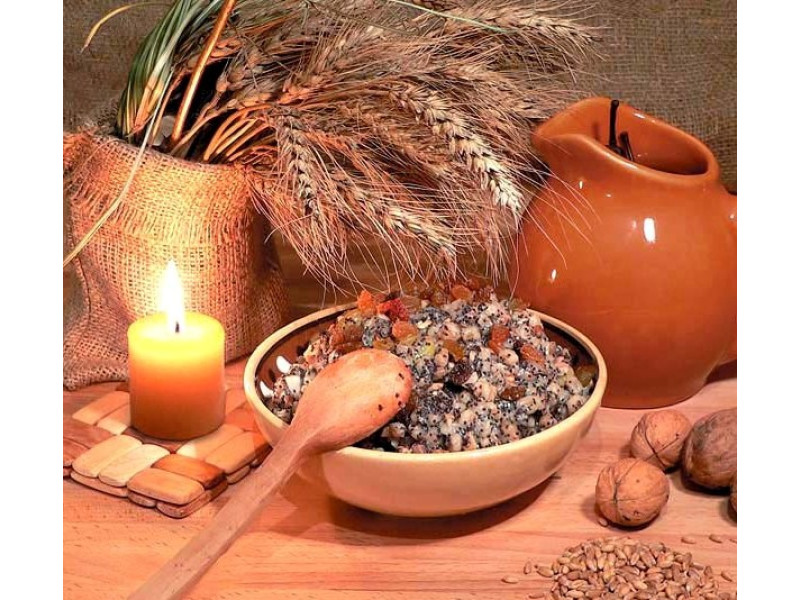
Write a comment